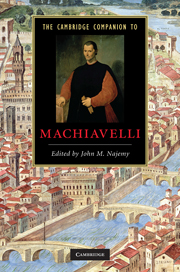Book contents
- Frontmatter
- Introduction
- 1 Niccolò Machiavelli: a portrait
- 2 Machiavelli in the chancery
- 3 Machiavelli, Piero Soderini, and the republic of 1494-1512
- 4 Machiavelli and the Medici
- 5 Machiavelli’s Prince in the epic tradition
- 6 Society, class, and state in Machiavelli’s Discourses on Livy
- 7 Machiavelli’s military project and the Art of War
- 8 Machiavelli’s Florentine Histories
- 9 Machiavelli and Rome: the republic as ideal and as history
- 10 Philosophy and religion in Machiavelli
- 11 Rhetoric and ethics in Machiavelli
- 12 Machiavelli and poetry
- 13 Comedian, tragedian: Machiavelli and traditions of Renaissance theater
- 14 Machiavelli and gender
- 15 Machiavelli’s afterlife and reputation to the eighteenth century
- 16 Machiavelli in political thought from the age of revolutions to the present
- Index
14 - Machiavelli and gender
Published online by Cambridge University Press: 28 September 2010
- Frontmatter
- Introduction
- 1 Niccolò Machiavelli: a portrait
- 2 Machiavelli in the chancery
- 3 Machiavelli, Piero Soderini, and the republic of 1494-1512
- 4 Machiavelli and the Medici
- 5 Machiavelli’s Prince in the epic tradition
- 6 Society, class, and state in Machiavelli’s Discourses on Livy
- 7 Machiavelli’s military project and the Art of War
- 8 Machiavelli’s Florentine Histories
- 9 Machiavelli and Rome: the republic as ideal and as history
- 10 Philosophy and religion in Machiavelli
- 11 Rhetoric and ethics in Machiavelli
- 12 Machiavelli and poetry
- 13 Comedian, tragedian: Machiavelli and traditions of Renaissance theater
- 14 Machiavelli and gender
- 15 Machiavelli’s afterlife and reputation to the eighteenth century
- 16 Machiavelli in political thought from the age of revolutions to the present
- Index
Summary
When Gabriele D'Annunzio fantasized a new king of Rome in his 1894 novel, The Virgins of the Rocks, he supplied him with a Machiavellian motto, taken not from The Prince, as might be expected, but from the lesser known Life of Castruccio Castracani of Lucca: “I have taken her, not she me [Io ho preso lei, non ella me].” This pithy saying, in rhetorical terms a chiasmus, appears among the concluding list of witticisms purportedly drawn from the life of the exemplary Castruccio, who “in all fortunes acted the prince”: “Once there was a young woman with whom Castruccio associated intimately. For this, being reproached by a friend of his who said especially that it was bad for him to let himself be taken by a woman, “You are wrong,” said Castruccio; “I have taken her, not she me.”” / As the rhetorical figure that is a crossing of four terms which, through their crossing, are set up as belonging to two categories, the chiasmus is the figure par excellence of reversal and inversion. In Castruccio's case, the wittiness of his reply depends precisely upon such a reversal. The episode might encapsulate the relation of gendered subjects and their objects in Machiavelli's work as a whole and in the tradition of political thought that he inaugurated and to which D'Annunzio was heir. Male and masculine subjects of action are not to be themselves subjected by female or feminine actors, even as the very reversibility built into the rhetorical form of the chiasmus represents precisely this possibility.
- Type
- Chapter
- Information
- The Cambridge Companion to Machiavelli , pp. 223 - 238Publisher: Cambridge University PressPrint publication year: 2010
- 1
- Cited by

